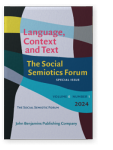compassion
Compassion as appraisal, performative identity and moral affiliation
A corpus perspective and digital activist strategic communication analysis
This article addresses the underexplored topic of compassion in digital activism through linguistic research.
Utilising corpus linguistics and the SFL appraisal framework, the study initially analyses the lemma “compassion” and its
appraisal nature within The Coronavirus Corpus. It then models compassion development as a social discursive process, taking
Boycott, Divestment and Sanctions (BDS-Australia) campaigns as a case study, drawing on “communion” and “tendering” strategies,
and positioning theory-based morality by linking structure to agency. The analysis provides evidence that the concept of
“compassion” extends beyond triggered emotions, expressing institutionalised feelings. Compassion also develops through a moral
affiliation process: aligning identities, positioning others within shared moral and sociocultural frameworks, and exhorting
people towards purposeful social actions as commodities. This research underscores compassion’s normative (i.e. moral orders) core
and performative essence.
Article outline
- 1.Introduction
- 2.Literature review
- 3.Method
- 3.1Data: The Coronavirus corpus and the BDS-Australia campaigns
- 3.2Data analysis procedure
- 3.2.1A corpus-informed analysis of the concept of “compassion”
- 3.2.2A moral affiliation analysis of compassion development
- 4.Results and discussion
- 4.1The corpus-based exploration of the lemma “compassion”
- 4.2Moral affiliation: Activating a moral order, forging alignment, positioning and exhortation
- 4.2.1Patterns of collocative values, key bonds and an activated moral order
- 4.2.2Value alignment: Communion affiliation tactics
- 4.2.2.1Attitudinal expansion tactic
- 4.2.2.2Iconisation tactic
- 4.2.2.3Indexical labelling tactic
- 4.2.2.4Attitudinal adequation tactic
- 4.2.2.5Illegitimation tactic
- 4.2.3Positioning others and exhortation of purposeful action
- 5.Conclusion and future implications
-
References
